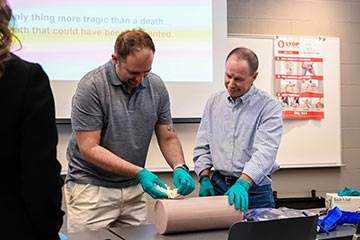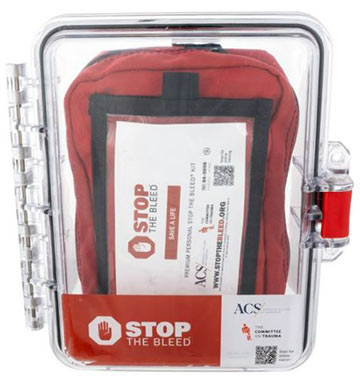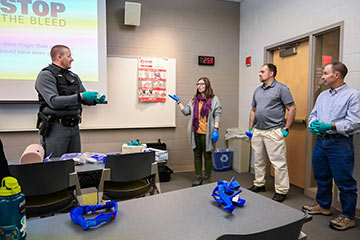
12/05/2023
Loss of blood can kill a person within five minutes, making early care critical to preventing a trauma victim from falling victim to one of the most common causes of preventable death.
“Stop the Bleed,” a new program on SUNY Cortland’s campus, is designed to give bystanders the tools that make a difference in those early moments.
Those tools include free training for all university community members and more than a dozen unique bleeding control kits strategically placed around campus.
“During a traumatic bleeding incident, the actions that are taken in those first precious minutes are critical in the 'chain-of-survival’” said Frank Cullen ’06, Emergency Manager for the University Police Department (UPD). “Nationwide, there are many instances of loss of life from bleeding that could have been prevented had there only been resources available.”
Rarely are medical professionals or first responders the first on the scene of an emergency, which is why Cullen said it’s vital to empower everyone to help when they can.

Free 90-minute training sessions on June 7th and November 8th at the Student Life Center were the first in a series giving students, faculty and staff a chance to learn about the new, red-colored kits installed on campus as part of the program. Eve Mascoli, assistant director of Recreational Sports for Facilities and Aquatics, and UPD Lt. Chris Austen are helping Cullen with the classes. At least two to three training sessions are expected to be held each semester.
The emergency kits contain gloves, bleeding control dressing, a tourniquet, gauze dressing, trauma shears and a marker, and can used by anyone present in an emergency to help mitigate a severe bleeding injury. The planned training sessions are designed to give those same bystanders the training and confidence needed to offer treatment until professional help arrives.
There are 14 kits on Cortland’s main campus, with plans for Antlers, Camp Huntington and Brauer Field Station of the William H. Parks Family Center for Environmental and Outdoor Education to have one kit each by next spring. Cullen hopes to keep adding kits to campus each year until all buildings have at least one onsite.
Currently, all kits are in buildings near existing AED (automated external defibrillator) cabinets, but Cullen encourages community members to use the university’s Emergency Preparedness website to brush up on where to find them before they’re needed.
“That page will give people a more in-depth understanding of the program and where the current kits are located on campus. Knowing where kits are beforehand can help save precious time during a traumatic bleeding incident and help to increase survivability for the injured party.”

According to the World Health Organization, hemorrhages are the most common worldwide cause of preventable deaths, with approximately 40% of trauma-related deaths from bleeding. The U.S. Centers for Disease Control reports “unintentional Injury” as the leading cause of death for people in the country aged 1 through 44.
The procedures for Stop the Bleed were developed by government and health care officials after the tragedy of the Sandy Hook Elementary shooting in Newtown, Connecticut. With lessons learned from both Sandy Hook and Tactical Combat Casualty Care used by the military in Iraq and Afghanistan, Stop the Bleed adapted those lessons to focus on simple techniques that could be applied to save lives in a wider scope of emergencies.
“I first had the idea of bringing the program to the campus after I had attended an event at another university and saw the kits in various buildings on that university’s campus,” Cullen said. “And while the program was developed from active shooter incidents, most kits are used more for noncriminal incidents such as accidents and workplace injuries.”
But whether or not a Stop the Bleed kit is nearby, Cullen advised to always follow basic rules in an emergency situation.
“First calm and keep your own personal safety mind,” he said. “In high-stress situations some people may be so focused on helping others that they fail to see the active hazards that can harm them. Once you’ve accounted for your own safety and if you’re trained, respond according to your training and immediately contact 911. For those that aren’t trained, seek help, call 911 and follow the instructions of the emergency dispatcher.”